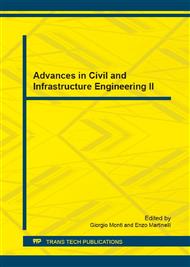[1]
Gambarelli, S., Nisticò, N., Ožbolt, J., Numerical analysis of compressed concrete columns confined with CFRP: Microplane-based approach, Composites, Part B 67 (2014), 303–312.
DOI: 10.1016/j.compositesb.2014.06.026
Google Scholar
[2]
Wang, L-M. and Wu, Y-F., Effects of corner radius on the performance of CFRP-confined square concrete columns: Test, Engineering Structure, 16(4) (2008), 1-13.
DOI: 10.1016/j.engstruct.2007.04.016
Google Scholar
[3]
Ožbolt, J., Li, Y. -J. and Kožar, I., Microplane model for concrete with relaxed kinematic constraint, International Journal of Solids and Structures, 38 (2001), 2683-2711.
DOI: 10.1016/s0020-7683(00)00177-3
Google Scholar
[4]
Mirmiran, A., Shahawy, M., Samaan, M., El Echary, H., Mastrapa, J.C., Pico O., Effect of column parameters on FRP-confined concrete. J Compos Construct – ASCE, 2(4) (1998), 175–85.
DOI: 10.1061/(asce)1090-0268(1998)2:4(175)
Google Scholar
[5]
Rochette, P., and Labossière, P., Axial testing of rectangular column models confined with composites. J. Compos. Constr. 4(3) (2000), 129-136.
DOI: 10.1061/(asce)1090-0268(2000)4:3(129)
Google Scholar
[6]
Pessiki, S., Harries K.A., Kestner, J.T., Sause, R., and Ricles, J.M., Axial behavior of reinforced concrete columns confined with FRP jackets. J. Compos. Constr. 5(4) (2001), 237-245.
DOI: 10.1061/(asce)1090-0268(2001)5:4(237)
Google Scholar
[7]
Ilki A., and Kumbasar N., Compressive behavior of carbon fiber composite jacketed concrete with circular and non-circular cross-sections. J Earthquake Eng. 7(3) (2003), 381-406.
DOI: 10.1080/13632460309350455
Google Scholar
[8]
Monti, G. and Nisticò, N., Square and rectangular concrete columns confined by CFRP: experimental and numerical investigation, Mech Compos Mater , 44(3) (2008), 289-308.
DOI: 10.1007/s11029-008-9021-1
Google Scholar
[9]
Rousakis, T.C., Karabinis A.I., Substandard reinforced concrete members subjected to compression: FRP confining effects. Materials and Structures 41 (2008), 1595-1611.
DOI: 10.1617/s11527-008-9351-4
Google Scholar
[10]
Rousakis, T.C., Karabinis A.I., Adequately FRP confined reinforced concrete columns under axial compressive monotonic or cyclic loading. RILEM Materials and Structures, Springer Netherland, 45(7) (2012), 957-975.
DOI: 10.1617/s11527-011-9810-1
Google Scholar
[11]
Nisticò, N. and Monti, G., R.C. square sections confined by FRP: analytical prediction of peak strength, Composites, 45(1) (2013), 127–37.
DOI: 10.1016/j.compositesb.2012.09.041
Google Scholar
[12]
Nisticò, N., R.C. Square sections confined by FRP: A numerical procedure for predicting stress–strain relationships, Composites, Part B 59 (2014), 238–247.
DOI: 10.1016/j.compositesb.2013.12.004
Google Scholar
[13]
Popovics, S., Mechanical Behaviour of Materials, Proceedings of the International conference on Mechanical Behaviour of Materials, IV, Japan, (1972), 172-183.
Google Scholar
[14]
Popovics, S., A numerical approach to the complete stress-strain curve of concrete, Cement and Concrete Research, 3 (1973), 583-589.
DOI: 10.1016/0008-8846(73)90096-3
Google Scholar
[15]
Mander, J.B., Priestley, M. J. N. and Park, R., Theoretical Stress-Strain Model for Confined Concrete, Journal of Structural Engineering, ASCE, 114(8) (1988), 1804-1826.
DOI: 10.1061/(asce)0733-9445(1988)114:8(1804)
Google Scholar
[16]
Spoelstra, M. R. and Monti, G., FRP-Confined Concrete Model, ASCE Journal of Composites for Construction, V. 3 (1999), No. 3, 143-150.
DOI: 10.1061/(asce)1090-0268(1999)3:3(143)
Google Scholar
[17]
Mirmiran, A., Zagers. K. and Yuan, W., Non-linear finite element modeling of concrete confined by fiber composites, Finite elements in Analysis and Design, 35 (2000), 79-96.
DOI: 10.1016/s0168-874x(99)00056-6
Google Scholar
[18]
Rousakis, T. C., Karabinis, A.I. and Kiousis, P. D., FRP-confined concrete members: Axial compression experiments and plasticity modeling, Engineering Structures 29 (2007), 1343–1353.
DOI: 10.1016/j.engstruct.2006.08.006
Google Scholar
[19]
Karabinis, A.I. and Kiousis, P. D., Effects of confinement on concrete columns: Plasticity approach, ASCE Journal of Structural Engineering, 120(9) (1994), 2747-67.
DOI: 10.1061/(asce)0733-9445(1994)120:9(2747)
Google Scholar
[20]
Karabinis, A.I. and Kiousis, P. D., Strength and ductility of rectangular concrete columns- A plasticity approach, ASCE Journal of Structural Engineering, 122(3) (1996), 267-74.
DOI: 10.1061/(asce)0733-9445(1996)122:3(267)
Google Scholar
[21]
Yu, T., Teng, J. G., Wong, Y. L. and Dong, S. L., Finite element modeling of confined concrete-I: Drucker-Prager type plasticity model, Eng. Struct, 32(3) (2010), 665-79.
DOI: 10.1016/j.engstruct.2009.11.014
Google Scholar
[22]
Nisticò, N., Pallini, F., Rousakis, T.C., Wu, Y-F., Peak strength and ultimate strain prediction for FRP confined square and circular sections, Composites, Part B, 67 (2014), 543-554.
DOI: 10.1016/j.compositesb.2014.07.026
Google Scholar
[23]
Gambarelli, S., Nisticò, N., Ožbolt, J., Microplane model for concrete: Part I. State of the art, Proceedings of the 2nd International Symposium on Advances in Civil and infrastructure Engineering (ACE), Vietri sul mare, (2015).
DOI: 10.4028/www.scientific.net/amm.847.95
Google Scholar
[24]
Yang, X.B., Nanni, A. and Chen, G. D., Effect of corner radius on the performance of externally bonded FRP reinforcement, In: Proceedings of the 5th international conference on non-metallic reinforcement for concrete structures, (CD-ROM), (2001).
DOI: 10.1201/9781482271621-71
Google Scholar
[25]
Bažant, Z. P. and Oh, B. H., Crack band theory for fracture of concrete, Materials and Structures, RILEM, 16(93) (1983), 155-177.
Google Scholar


